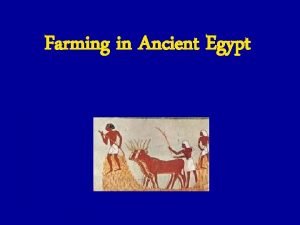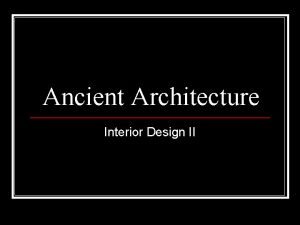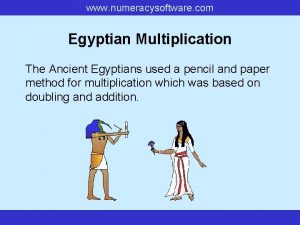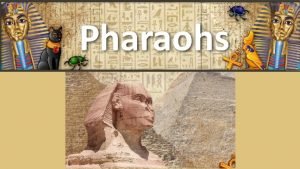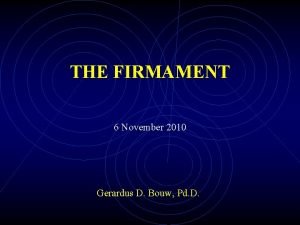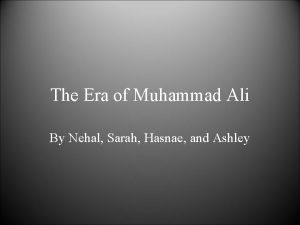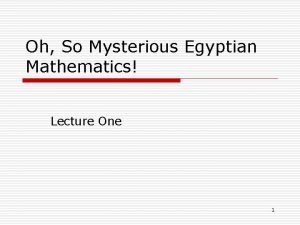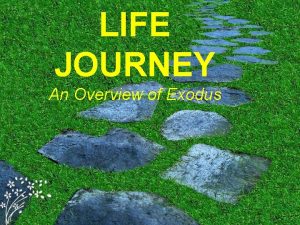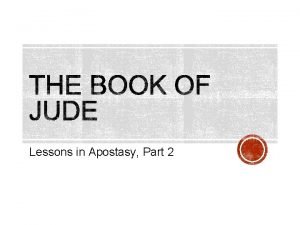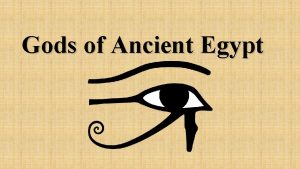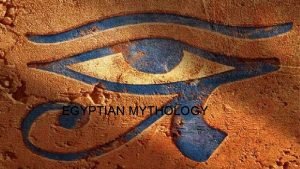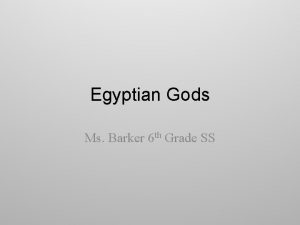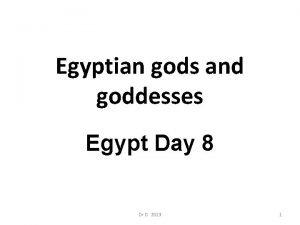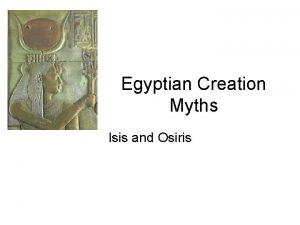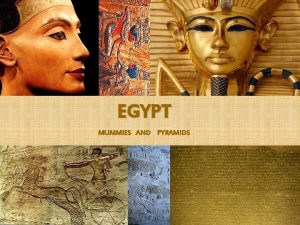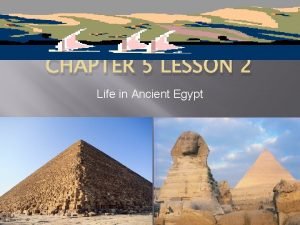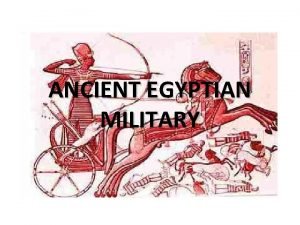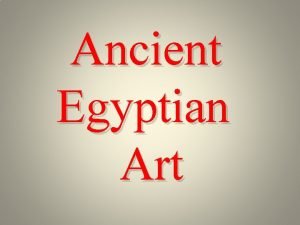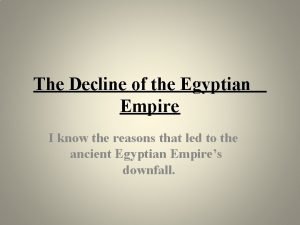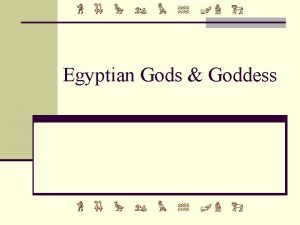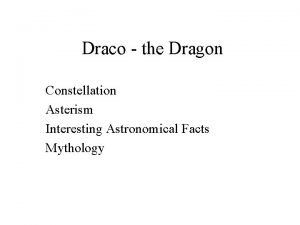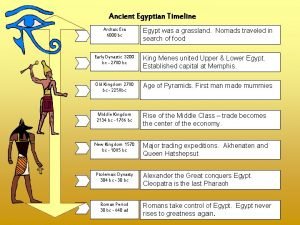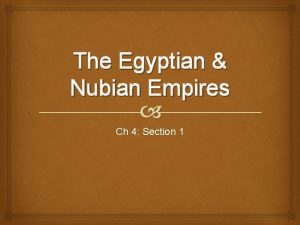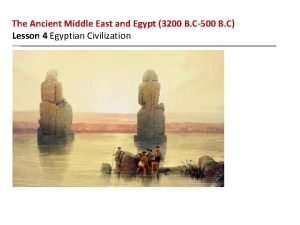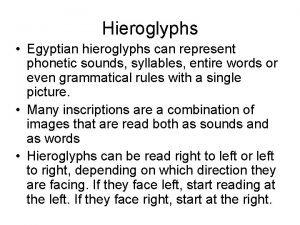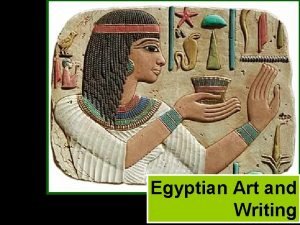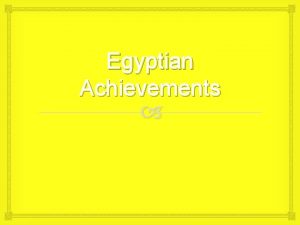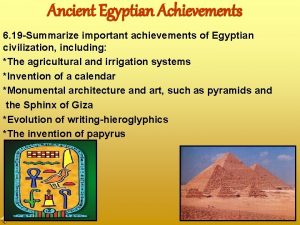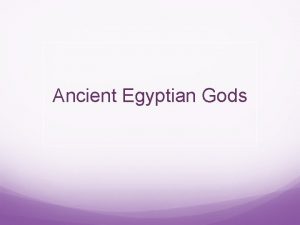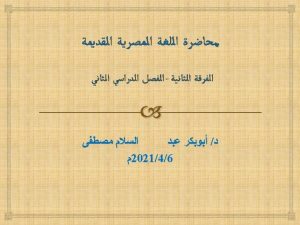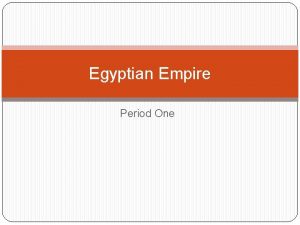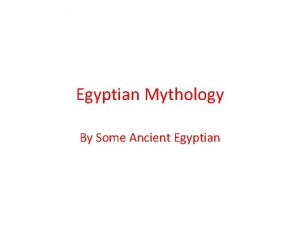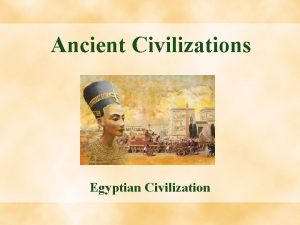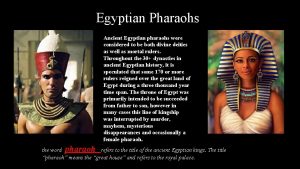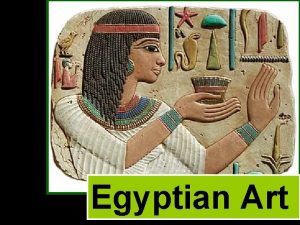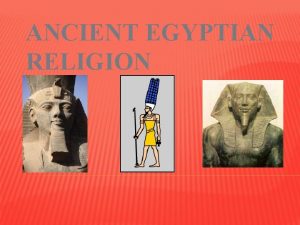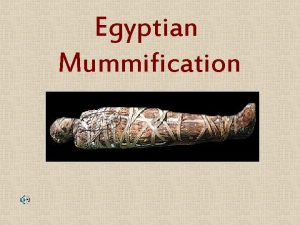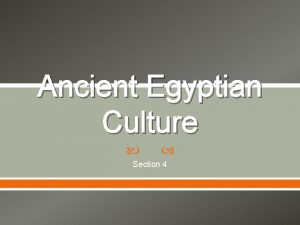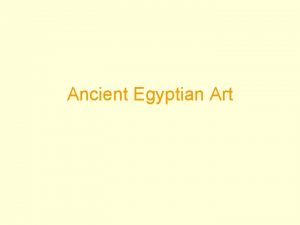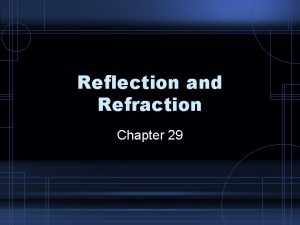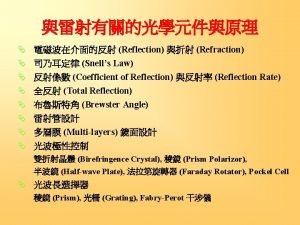Ancient Egyptian Architecture Architecture as a Reflection of



































































- Slides: 67

Ancient Egyptian Architecture: Architecture as a Reflection of Society

Lesson Objectives Before you leave today, you will be able to: – Identify what types of architectural structures were built in Ancient Egypt – Identify & Explain what purposes different architectural structures served in Ancient Egypt – Identify who designed & built the architectural structures (pyramids, temples, obelisks, etc. ) Explain how Architecture created in Ancient Egypt reflects the values and ideals of Ancient Egypt

Temples

Purposes of Temples • The temples were was the House of Worships to the many the Gods and Goddesses the Ancient Egyptians worshipped. • All was to be kept clean and in order according to the laws of Maat. – If not - the god or goddess would leave and great unrest would result for Egypt.

Standard Temple Layout • Essentially, the standard temple followed a tripartite plan, consisting of three basic elements – an outer court – a hypostyle (or columned) hall – the sanctuary itself. • These could be multiplied and enclosed by auxiliary rooms but the basic design was fairly consistent. – A common addition was an enormous gateway known as a pylon at the entrance of each courtyard, providing a more grandiose approach. • The various elements were arranged symmetrically, along a single avenue of approach, ideally running from east to west and facing the Nile (although this was not always possible). • It was meant to be a microcosm of the cosmos at the time of Creation.

Standard Temple Layout

Obelisks • Obelisks (tekhen) were a very ancient and characteristically Egyptian type of dedication. • Originally it was probably an amorphous stone, set upright to represent the benben on which the rays of the rising sun first fell at the dawn of creation. The Obelisk at Luxor by David Roberts

Obelisks • The original was at the temple of the sun-god at Heliopolis and was believed to represent the petrified semen of Re'Atum. • The New Kingdom versions erected in pairs, flanking the entrance to the temple or separating one element of the complex from the next. • Their quarrying, transport and erection was an enormous undertaking and pharaohs did not hesitate to advertise the fact. Heliopolis Obelisk

Obelisks • They were long, tapering four-sided shafts with a pointed pyramidion at the top. • The sides were carved with relief's and inscriptions commemorating significant events in the reign of the pharaoh. • Hewn out of a single block of stone, they could reach as high as 30 meters or more and might weigh as much as several dozen tons. The Luxor obelisk in the Place de la Concorde in Paris

The Outer Courts • • • The Forecourt (wba) which lay behind the pylon was a large space, used for the assembly of fairly large numbers of people, and formed a link between the realms of gods and men. It was normally what is known as a peristyle courtyard which means that there was a colonnade running along its perimeter. The interior— in New Kingdom times, at least—was generally • uncluttered by other structures, although an altar, set to one side • of the main axis, was often present. Courtyard of Ramesses II at Luxor The setting was considered ideal for royal statues as well as those of private individuals. A large number of statues have been recovered from large pits (known as 'cachettes') in the courtyards of the Karnak and Luxor Temple— the latest at Luxor in 1989. (Shown Above)

Ramesseum

The Outer Courts • The royal statues were most often set in the spaces between the columns lining the perimeter and acted as protectors of the sacred space. • They often took the appearance of the god Osiris, wrapped up like a mummy with only the head showing. Osirian statues and head of a fallen colossus at the First Court of the Ramesseum (Mortuary Temple of Ramesses II), on the west bank of the River Nile at the site of the ancient Egyptian capital of Thebes. (1970)

The Outer Courts • The private statues were mainly votive offerings, placed in the courtyard to remind the gods, by their perpetual presence, of the piety of the individual. • They usually took the form of 'block statues, depicting the individual squatting on the ground or kneeling to present their offerings to the god.

The Hypostyle Hall • The Hypostyle Hall (Egyptian: wadjit) sits across the main axis of the temple and is normally as broad as the width of the courtyard in front of it. • Sometimes it was separated from the courtyard by another pylon, as was the case with the great hypostyle hall of Seti I at Karnak. • At Luxor on the other hand, Amenophis III built his hall directly onto the courtyard with only a balustrade to separate them.

The Hypostyle Hall Entrance The main entrance was through a door on the main axis, used for the 'boat-procession' of the god—side doors were used for the regular offerings of food and drink.

• The room was filled with columns that flanked the central passage, which was generally open while the others were buds. • The central columns were also somewhat higher to allow for grilled clerestory windows just below the ceiling which let in dim, filtered light, so that the hall served as a transition from the bright glare of the courtyard and the total darkness of the sanctuary. • The reliefs on the walls depict the pharaoh, usually in a short kilt, taking part in the Heb. Sed or a procession of the god. • Later temples had one or two additional halls—one of which was called the “Hall of Appearance” and another the “Hall of Offering”. The Hypostyle Hall Entrance to the Hypostyle Hall at the Temple of Horus, Edfu. (1970)

The Hypostyle Hall View inside the Hypostyle Hall from the Sanctuary, where there are eight rows of six columns, at the Ramesseum (Mortuary Temple of Ramesses II), on the west bank of the River Nile at the site of the ancient Egyptian capital of Thebes. (1970)

Egyptian Columns Egyptian columns came in a variety of types—over 30 have been identified—with the selection depending on the setting in which they were used. Since the temple itself was essentially a simple reed hut translated to stone, the design of the columns was largely based on the plants which were used to support it.

Egyptian Columns The two examples shown left are based on the lotus plant— the on the left shows a lotus flower column with an open blossom while that on the right represents a lotus bud column Another version has an unopened papyrus bud at the top. Generally, the 'bud' types were used in the outer courts and away from the main axis of the temple while the 'open' types are more common in the central areas. Other plant forms include types based on the palm and the lotus.

Egyptian Papyrus Columns Exterior carved papyrus columns in the ruins of the Hypostyle Hall, at the Temple of Haroeris, Komombo, on the banks of the River Nile, Egypt. (1970)

The Sanctuary • The most sacred and intimate part of the temple was the tiny room at the back of the building where the image of the god was kept. • It was accessible only to the king and the high priests. • The sanctuary was on the main axis of the temple with a set of double doors looking back towards the entrance.

The Sanctuary • If there was more than one deity involved —in a triad for example —the shrines of the secondary ones would be off to the side. • The other principal type was the barque shrine, a narrow, open-ended structure with a plinth in the centre to hold the sacred boat containing the statue of the god. • The walls were decorated with reliefs depicting the most intimate details of cult practice. The inner sanctuary inside the Great Temple of Abu Simbel with figures carved into the rock depicting Ramses II in honour of himself and the triad Amon-Ra, Ptah and Ra-Harakhte.

The Sanctuary • The cult image itself might be of gilded wood or stone but was often were of solid gold or silver (representing the divine flesh of the gods). • The eye-sockets were generally inset with semi -precious stones and inlays of lapis lazuli were used to represent the hair. • Under the circumstances, it is hardly surprising that none of these statues have survived. Shrine and pedestal inside the Sanctuary at Temple of Horus, Edfu, Egypt. (1970)

The Ramesseum: the Floor Plan • The Ramesseum is the 'mortuary temple' of king Ramesses II (about 1279 -1213 BC). • In the Third Intermediate Period the area was used as cemetery. • Small chapels were built into the magazines. Orange marked: area where a late Middle Kingdom (about 1800 - 1750 BC) tomb with a box of papyri was found. Black: mud brick White: reconstructed; Hatched: standing stone walls

The Ramesseum: the Floor Plan of the Main Temple 1. First Entrance Pylons (destroyed in antiquity) 2. First Court - Only a single colonnade remains of the First Courtyard 3. The royal palace, located left of the first court 4. Second Pylons (only the north tower remains) 5. Second Court - Much more complete then the first, it is flaked both left and right by pillarered porticos with Osiride statues of Ramses. 6. Hypostyle hall - with 48 columns, 29 columns that are still standing and support the well preserved ceiling, the ones in the middle are shorter than those on the sides to allow light into the Temple by traceried windows

The Ramesseum: the Floor Plan of the Main Temple 7. Adjacent to the north of the hypostyle hall dedicated to Ramses's mother, Tuya, and his chief Queen Nefertari 8. Second hypostyle hall known as the “Hall of Astronomy” where the first 12 month calendar is illustrated 9. Two vestibules (in ruins) 10. The inner Sanctuary of Ramses - dedicated to Amun-ra and Ramses II. now in ruins 11. Annex rooms and library (in ruins)

Ramesseum

Ramesseum Fallen colossus of Ramesses II; Ramesseum, Luxor.

The Ramesseum

The Ramesseum

Ramesseum

The ancient Egyptians also built beautiful temples. This is the Temple of Re The post and lintel system was used to build this temple.

Nubian temples of Abu Simbel.

The Luxor temple

The Temple of Dendur, ca. 15 B. C. E. ; Roman period Egyptian; Nubia, Dendur Sandstone; L. from gate to rear of temple 82 ft. (24 m 60 cm)

Purposes of Pyramids • The greatest architectural achievements of the Ancient Egyptians were the pyramids. • Pyramids were built as tombs for the pharaohs. • They contained the items that the Egyptians believed that the Pharaoh would need in the afterlife. • Much of the art that remains was preserved in the pyramids.

• A major problem facing the builders of the Ancient Egyptian Pyramids, was that of getting the Large stone blocks to the height they required. the method shown at left, is the only one proven to have been used. • The ramps were built on inclined planes of mud brick and rubble. • They then dragged the blocks on sledges to the needed height. • As the pyramid grew taller, the ramp had to be extended in length, and its base was widened, else it would collapse. • It is likely that for the construction of each pyramid, several ramps were probably used. Pyramid Construction

• The arrangement of the ramps used for building is in much dispute. • Assuming that the step pyramid was built before the outer structure, and then the packing blocks were laid on top, the ramps could have run from one step to another rather than approaching the pyramid face at right angles. Pyramid Construction

• Architects and builders used a different form of construction in the pyramids of the 12 th and 13 th Dynasties. • Mainly because of economy, for it was suitable for relatively modest structures in inferior materials. Solid walls of stone ran from the center, and shorter cross walls formed a series of chambers filled with stone blocks, ruble or mud bricks. • An outer casing was usually added, and although quite effective in the short term, it did not even come close to the earlier construction methods. • Pyramids which were built with this structural design are quite dilapidated and worn. Pyramid Construction

Who Built the Pyramids? • Like 20 th century bridge designs, the Pyramid's cornerstones have balls and sockets built into them. • They are several football fields long • Like bridges of today, the Pyramid is subject to expansion and contraction movements from heat and cold, as well as earthquakes, settling, and other such phenomena. • After 4, 600 years it's structure would have been significantly damaged without such construction.

Who Built the Pyramids? • While the bulk of the Pyramid's core was constructed of 4, 000 - to 40, 000 -pound blocks of soft limestone, the outer layer of the Pyramid was made of a beautifully bright, protective layer of polished stone. • These outer "casing stones" are missing today because about 600 years ago they were stolen by Arabs, (This accounts for the very worn appearance of the Pyramid today, since the inner limestone blocks are not immune to attack by the elements-wind, rain, and sandstorm. ) • This protective covering was made up of 100 -inch-thick, 20 ton block of hard, white limestone, similar to marble but superior in hardness and in durability against the elements.

• Today, while the question of exactly how many men it would have taken to build the Great Pyramid at Giza remains unanswered, we can speculate on certain elements of the workforce. • It was once believed that slaves built the great pyramids, but scholars have uncovered that it was skilled workers, not slaves who built the pyramids. Who Built the Pyramids?

• The Ancient Egyptians became great labor organizers. Part of the labor force working on the pyramids would have been organized as a crew, perhaps consisting of 2, 000 men. • This crew was divided into two gangs of 1, 000 workers, which in turn was divided into five zaa (in each gang), a term that was translated by the ancient Greeks as "phyloi" or phyle, meaning tribe, group or brotherhood. • Each Phyle consisted of about 200 mean. Who Built the Pyramids?

• It is possible, or even probable that these two types of construction teams may have been largely made up of a relatively skilled, permanent royal work force. • However, it is clear, given the volume of work required to construct the Great Pyramid, that more workers were needed. • These workers were probably helpers, and if slaves were used at all, they would have probably been included in this larger workforce. • However, many of these helpers were probably unskilled agricultural workers employed on a seasonal basis during the Nile inundation. Who Built the Pyramids?

• • • Miroslav Verner claims a somewhat lower estimate, including carpenters to make tools and sledges, metal workers to make and sharpen cutting tools, potters to make pots for food preparation and hauling water for mortar and other purposes, bakers, brewers and others, consisting of between 20, 000 and 25, 000 workers at any one time. In fact, as the pyramid grew, fewer and fewer men were probably required, for work at the top required much less stone and the construction space became more limited. This number of men, which was probably drastically reduced during the agricultural seasons, probably finished the Great Pyramid of Khufu in less then 23 years. Who Built the Pyramids?

• The first pyramid was built for King Zoser. It was a “step pyramid”. It was designed and built by an artist and architect named Imhotep. • Imhotep is the first artist whose name is recorded in history. • This pyramid was built about 2600 BC.

The three “great pyramids” are located at Giza.

The Giza Pyramids are guarded by the Great Sphinx. The sphinx is carved from a rocky ledge. It was damaged by Muslim vandalism and sand wind.

The Great Pyramid at Giza, the oldest and largest of the pyramids built by the 4 th-Dynasty king, Khufu (Cheops) (2589 -66 BC). Also visible is the space-age shape of the Solar Boat Museum. • The greatest architectural achievements of the Ancient Egyptians were the pyramids. • Pyramids were built as tombs for the pharaohs. • They contained the items that the Egyptians believed that the Pharaoh would need in the afterlife. • Much of the art that remains was preserved in the pyramids.

Tutankhamun Sarcophagus About 1340 BC

This gold mask rested on the head of the mummy of King Tutankhaman.

King Tut’s Tomb

Tutankhamun's sarcophagus and coffin

Its walls are painted with scenes of Tutankhamun in the afterworld - the ritual of "opening the mouth" to give life to the deceased, the solar bark on which one travels to the afterworld, and Tutankhamun's ka in the presence of Osiris.

Off the burial chamber is the Treasury room, where a magnificent gilded canopic shrine was found. This was the most impressive object in the Treasury

Right: A gold chest held four canopic jars containing the dead pharaoh's viscera (internal organs -- lungs, stomach, intestines and liver). Below: Tutankhamun's canopic chest and lids in the form of human heads

The first room is the antechamber where many of the household items for Tutankhamun's voyage to eternity were found.

The first room is the antechamber where many of the household items for Tutankhamun's voyage to eternity were found.

The first room is the antechamber where many of the household items for Tutankhamun's voyage to eternity were found.

The Great Pyramid of Cheops, Giza, Egypt.

The Sphinx

The Sphinx • Carved from the bedrock of the Giza plateau, the Sphinx is truly a mysterious marvel from the days of ancient Egypt. • The body of a lion with the head of a king or god, the sphinx has come to symbolize strength and wisdom. The Great Sphinx

The Sphinx The Great Sphinx • From the north side the profile of the Sphinx reveals the proportion of the body to the head. It would appear as though the head is small in proportion to the body. • Because of the changing desert terrain, the body of the Sphinx has been buried several times over the past several thousand years. • Most recently in 1905, the sand has been cleared away to expose the magnitude and beauty of the entirety of the Sphinx. • The paws themselves are 50 feet long (15 m) while the entire length is 150 feet (45 m). The head is 30 (10 m) feet long and 14 feet (4 m) wide. • Because certain layers of the stone are softer than others, there is a high degree of erosion that has claimed the original detail of the carved figure.

The Sphinx The Great Sphinx • The most popular and current theory of the builder of the Sphinx holds that it was commissioned by the 4 th Dynasty King, Khafre (2558 -2532 BCE). • Khafre was one of the sons of Khufu (AKA Cheops). • The Sphinx lines up with the Pyramid of Khafre at the foot of its causeway. • As one rounds the northeast corner to the front of the Sphinx, the alignment of the two structures becomes more apparent.

The Sphinx The Great Sphinx • Although the head of the Sphinx is badly battered in some places, traces of the original paint can still be seen near one ear. • Originally it is believed that the Sphinx was painted and was quite colorful. Since then, the nose and beard have been broken away. • The nose was the unfortunate victim of target practice by the Turks in the Turkish period. • It is often erroneously assumed that the nose was shot off by Napoleon's men, but 18 th century drawings reveal that the nose was missing long before Napoleon's arrival.


Conclusions & Lesson Review 1. Identify what types of architectural structures were built in Ancient Egypt. 2. Identify & Explain what purposes different architectural structures served in Ancient Egypt 3. Identify who designed & built the architectural structures (pyramids, temples, obelisks, etc. ) 4. Explain how Architecture created in Ancient Egypt reflects the values and ideals of Ancient Egypt.
 Byzantine floral designs
Byzantine floral designs Ancient desert clothing
Ancient desert clothing Ancient egyptian transportation
Ancient egyptian transportation Middle age floral design
Middle age floral design What crops did ancient egypt grow
What crops did ancient egypt grow Ancient egypt social hierarchy
Ancient egypt social hierarchy Ancient egyptian interior design
Ancient egyptian interior design Ancient egyptian frontalism
Ancient egyptian frontalism Ancient roman toothbrush
Ancient roman toothbrush Ancient egyptian slaves
Ancient egyptian slaves Egyptian multiplication
Egyptian multiplication Ancient egyptian commoner clothing
Ancient egyptian commoner clothing Hans and gretel egypt menu
Hans and gretel egypt menu Ancient egyptian technology
Ancient egyptian technology Chapter 8 the ancient egyptian pharaohs test
Chapter 8 the ancient egyptian pharaohs test What is atum the god of
What is atum the god of Diffuse reflection vs regular reflection
Diffuse reflection vs regular reflection Means of communication in ancient times
Means of communication in ancient times Ancient india vs ancient china
Ancient india vs ancient china Ancient greek theatre architecture
Ancient greek theatre architecture Amut egyptian god
Amut egyptian god Egyptian throwing stick
Egyptian throwing stick The 10 plagues and egyptian gods
The 10 plagues and egyptian gods Plank length
Plank length Muhammad ali
Muhammad ali Hippo god egypt
Hippo god egypt Rx egyptian symbol
Rx egyptian symbol Egyptian fractions
Egyptian fractions Egyptian vs pima cotton
Egyptian vs pima cotton Virus
Virus Egyptian goddess of medicine
Egyptian goddess of medicine The devilfish in egyptian waters
The devilfish in egyptian waters The 10 plagues and egyptian gods
The 10 plagues and egyptian gods 10 plagues of egypt explained
10 plagues of egypt explained Aten symbol
Aten symbol Fsi egyptian arabic
Fsi egyptian arabic Egyptian god khonshu
Egyptian god khonshu Egyptian god of storms
Egyptian god of storms Atum
Atum Ennead egyptian mythology
Ennead egyptian mythology Egyptian cotton worm
Egyptian cotton worm Ka aper
Ka aper Ren egyptian god
Ren egyptian god Lesson 2 life in egypt
Lesson 2 life in egypt Egyptian fractions
Egyptian fractions Egyptian color palette
Egyptian color palette Hippo egyptian god
Hippo egyptian god The egyptian empire
The egyptian empire Egyptian apep
Egyptian apep Egyptian flood myth
Egyptian flood myth Interesting facts about draco constellation
Interesting facts about draco constellation Who created the devilfish in egyptian waters
Who created the devilfish in egyptian waters Nubian religion
Nubian religion Social classes
Social classes Echem egypt
Echem egypt Chapter 4 section 1 the egyptian and nubian empires
Chapter 4 section 1 the egyptian and nubian empires Ian woolford
Ian woolford Social hierarchy ancient egypt
Social hierarchy ancient egypt Egyptian hieroglyphs sounds
Egyptian hieroglyphs sounds Egyptian irrigation systems
Egyptian irrigation systems Rosetta
Rosetta Why was the calendar an important egyptian achievement
Why was the calendar an important egyptian achievement What is easter and why it is celebrated
What is easter and why it is celebrated Russian easter traditions
Russian easter traditions Egyptian simbols
Egyptian simbols Egyptian irrigation systems
Egyptian irrigation systems Egyptian herbarium
Egyptian herbarium Egyptian ankhing
Egyptian ankhing




